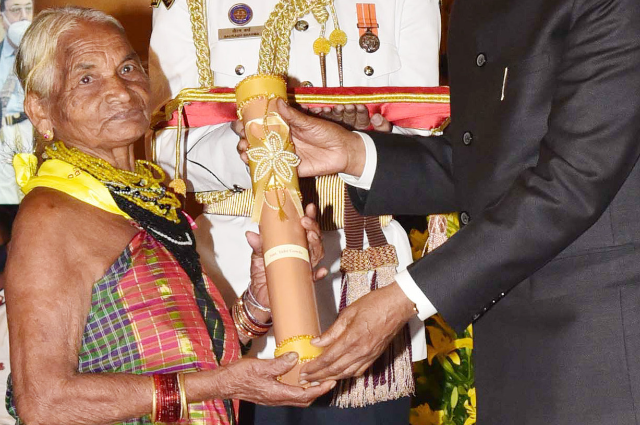The beauty of the forest embraces everything, from a magnificent landscape to simply paying attention to a tree or an animal. However, one-third of the world's forests have been gone. Many trees are being cut down in the modern era, resulting in deforestation. Countless animal species are threatened with extinction as a result of increasing population, industrialisation, urbanisation, and other factors - 60 percent of our planet's vertebrate wildlife populations have been lost in the previous 40 years, mostly due to habitat loss. Because of the connection between deforestation and climate change, forest or tree conservation is a high priority globally.
Both men and women play a role in the exploitation of resources, such as trees. But somehow women have always been connected with nature - figuratively, as in ‘mother Earth.' One of the cosmic myths of our current culture is: women are closer to nature than men. The phrase says it all: a 'virgin' forest is one that has not yet been plundered by humans, by man. The forest was believed to be female. While she has two natures: one is the nurturing, gentle mother, and the other is wild and unpredictable. Being bound to the realm of nature teaches women about the many ways in which we are all related to the forest. Once we realise the historical connections between women and trees, as well as their following oppression, we can't help but take a stance against the battle against nature. The best example for this is the famous tree hugging movement (Chipko movement), which began in 1974 in the Himalayan Garhwal region. The king of Jodhpur directed his ministers to gather wood for his new palace's building. The minister and the soldiers went to Bishnoi village for this reason. A Bishnoi woman named Amrita Devi, together with her daughter and hundreds of other Bishnois, stood up and stopped them from cutting down trees. They embraced the trees and died at the hands of the king's soldiers. The king was forced to abandon his plan to take down trees due to the village's opposition. Forest fairies exist in the actual world today, guarding the trees and guiding change.
Tulasi Gowda is a septuagenarian from Honnali village in Karnataka taluk Ankola, who was born into a poor family and couldn't get an education. Despite this, she is now referred to as an "encyclopaedia of forest knowledge." She has been planting trees since she was a child, studying their needs and environments. Tulasi has helped the local forest service cultivate trees for decades, having planted over a million saplings. Her exceptional contribution to environmental conservation and rejuvenation has been recognised with a Padma Shri in 2020, despite the fact that she continues to live in a humble rural setting. Saalumarada Thimmakka, another 100-year-plus environmentalist, was born into a poor family in Gubbi taluk, Tumkur district, Karnataka. She married early, worked as a coolie, and then began planting banyan trees with her husband, diverting their disappointment at not being able to have children into caring for nature. She has cared for and protected over 8,000 trees to date. In 2019, Thimmakka, now known as 'Saalumarada' or 'rows of trees,' received the Padma Shri award. Another forest warrior, Kerala's Kollakkayil Devaki Amma, has transformed 4.5 acres of her ancestral land into a lush forest with over 1,000 trees of common, uncommon, endangered, and biologically important species that support a diverse range of animals. For her outstanding contribution to the environment, she received the Nari Shakti Puruskar.
Ecofeminism is in total contravention to colonialism and capitalism's growth ideals! Significant participants, such as these inspiring women, will not allow the ecofeminist spirit to fade away. The current environmental issues were mostly created throughout the last 200 years of colonialism and exploitative capitalism. So, while the industrial machine has been increasing pace over the previous 200 years, women have been devoting their time and energy to saving trees and wildlife. Community forest management is dominated by men, as most forestry officers are male and because women’s participation in forest user committees and community-based adaptation programmes are less. That suggests to me that if women had more power and greater influence, they would have developed a variety of environmental-friendly activities. This is crucial because it is quite easy for women to fade into the background when they are not recognized. We've had generations of mediation experience, dealing with interpersonal issues on a daily basis in our homes. Women have learned to think in dualities in the same way that males do. We do, however, require some common ground with one another and with our environment. Women's values, which are centred on life-giving, must be revalued and elevated from their once subordinate social position. What women have learned through their lives deserves to be acknowledged and respected.
Women have an integral part in forest preservation and upkeep. Research suggests that women's decision-making in forest management improves biodiversity and forest health. Women, who sustain in indigenous communities are the prime leaders in the age-old forests, hence they play a critical role in their environmental, social and economic aspect. These women are generations of humans who live harmoniously with nature. Acknowledging and promoting women in community forest management is critical not merely for achieving equality, but also for improving the wellness of our forests. By respecting their wisdom and leadership, we can encourage actions that benefit both nature and the communities that rely on it. As we push for all of these enhancements, let us commit to strengthening the voices of females in ecological conservation, maintaining a healthy and dynamic ecology for future generations.

